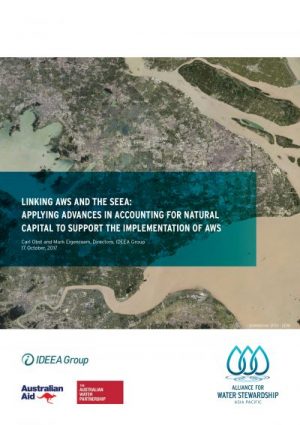
Accounting for Ecosystem Outcomes and the AWS Standard
The AWS International Water Stewardship Standard (the AWS Standard), provides a systematic approach for companies to improve their water use and the quality of their involvement in the management of water resources. The ambitions of the AWS Standard imply recognising a connection between site and firm level information and plans with respect to water and more aggregated data at catchment level and above.
In parallel, the international statistical community has worked progressively towards the adoption of the System of Environmental-Economic Accounting (SEEA) framework in which a wide array of data relating to environmental stocks and flows, including water, are integrated with economic data to provide a more complete picture of the relationship between human activity and the environment. In providing international standards the general focus has been on national or large jurisdictional level reporting. However, more recent work to incorporate information on ecosystems and biodiversity, has shown the capacity for SEEA to be applied at finer scales, including at catchment and finer scales.
Measurement and evaluation is a central feature in the “6 step” continuous improvement approach of the AWS Standard. The IDEEA Group paper examines the potential to make connections between the measurement framework and approach of the SEEA and the information designed and collected for the AWS Standard. It also considers the role that SEEA can play in establishing a broader context for implementation and communication of the AWS Standard.
In broad terms, there are four key connections that enable the SEEA and the AWS Standard to be linked. These are through the provision of:
- context
- classifications and boundaries for measurement
- support for impact analysis and evaluation
- accounting and reporting structures.
The paper finds clear potential for a number of benefits to accrue at firm and site level from the application of SEEA based measurement standards. Key benefits emerge from the SEEA’s potential to integrate information on water resources with data on other environmental stocks and flows and on economic activity. This means it can support a discussion of different planning options at the firm level. This can drive context-based, target setting and best practice, rather than more simply applying industry wide benchmarks of, for example, water use.
Further, since the SEEA is being applied in an increasing range of situations, well-beyond water resources, there is a higher chance of engaging in a commonly understood way beyond the AWS Standard, for example, with regard to biodiversity and land use change.
More broadly, data integration provides the system-wide information that limits the potential for unintended consequences from operational decisions and reflects the principles of Integrated Water Resources Management (IWRM).
From a measurement perspective, the SEEA represents a single, internationally agreed standard and is further underpinned by the International Recommendations for Water Statistics. The use of these statistical standards by firms implementing the AWS Standard would therefore be of direct benefit in:
- ensuring the ability to use data from public data sources where SEEA based data are compiled
- increasing the potential for comparison across sites and catchments, and across scales
- improving the alignment of data across different aspects of water resources measurement (e.g. between condition of water resources and the condition of important water related areas (IWRA))
- supporting consistent messages on the status of water resources from site level to catchment and national level
- reducing costs of data collection and reporting where multiple streams of reporting are required
- reducing associated costs of training and data infrastructure development that can be more easily shared.
While the focus of the paper is on the potential for the SEEA to support implementation of the AWS Standard, the reverse is also true. That is, to the extent that a given entity or catchment adopts the AWS Standard and uses the SEEA framework to underpin measurement, there is a clear potential for the information collected through the AWS Standard to be further utilised in the generation of SEEA based accounts – particularly water and ecosystem accounts – at higher scales.





